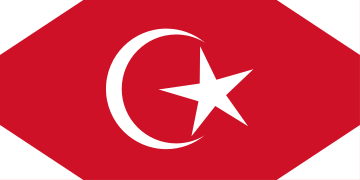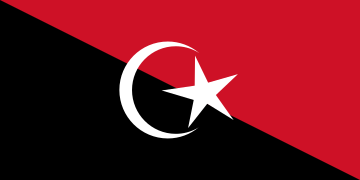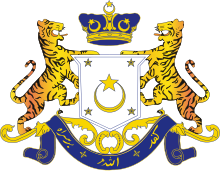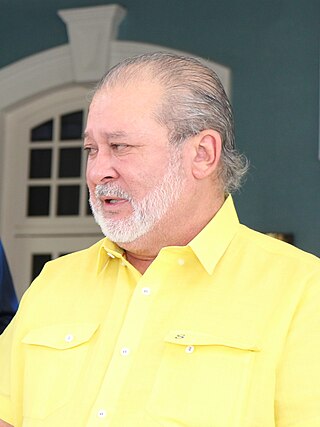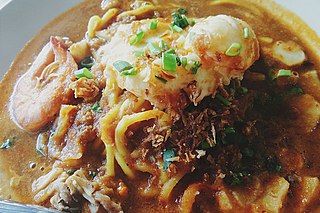Flag
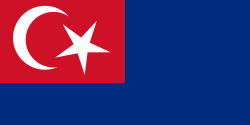 | |
| Use | Civil and state flag |
|---|---|
| Proportion | 1:2 |
| Adopted | 1871 |
| Design | Navy blue with a bright red field on the upper left canton, containing a white crescent and five-pointed star |
Design
Johor's state flag bears a canton pattern, a predominantly navy blue design with a bright red field on the upper left canton (quarter), which contains a white crescent and a white five-pointed star. [1] Running slightly less than half the length of the flag, the field unconventionally occupies roughly three fifths of the flag's hoist. In addition, the crescent is not aligned upright, tilting to the right towards the lower fly end and wrapping slightly around the star, which is positioned towards the lower right corner of the field. [1]
The flag in general attempts to symbolise Johor as a whole. The navy blue, which occupies roughly three quarters of the flag, represents the universe, [1] or the state government. [2] The red represents the warriors that defend the state, while the white crescent and white star denote Islam and Johor's sovereign ruler, respectively. [1] [2]
Variants
The vast majority of flags in use or formerly used by officials and government branches in the state borrow elements of the state flag, some of which are merely recolours. With the introduction of a unified state flag, many of them became obsolete, with the exception of the Royal Standards.
Standards
A series of Royal Standards are flown by the Sultan of Johor and his family, which lower-ranking members are assigned specific Standards. In addition, standards were also adopted for traditional high-ranking officials, including the bendahara , the Temenggung and the Sultan's Marshall. [1] [3]
The Standards are typically plain flags with a star (of varying numbers of points) and crescent, with truncating triangles placed on each corner of the flag; only the Standards of the Sultan and the Crown Prince are depicted without the truncations. In addition, each flag, with the exception of the Sultan's Enquerries, are coloured in only two colours, including white, blue, red and yellow. The number of points on the star also determines the rank of the Standard holder: The Sultan's Standard depicts a nine-pointed star, while the Standard for other members of the royal family depicts a five-pointed star.
The series of Standards include: [3] [4]
- the Standard of the Sultan:(Bendera Duli Yang Maha Mulia Baginda Sultan) A white flag with a blue nine-pointed star and crescent;
- the Standard of the Permaisuri:(Bendera Duli Yang Maha Mulia Baginda Permaisuri) A blue flag with a white seven-pointed star and crescent and four white triangles on each corner;
- the Standard of the Crown Prince:(Bendera Duli Yang Amat Mulia Tunku Mahkota) A white flag with a red seven-pointed star and crescent;
- the Standard of the Crown Prince's Consort:(Bendera Yang Amat Mulia Suri Waris) A red flag with a white five-pointed star and crescent and four white triangles on each corner;
- the Standard of the Raja Muda:(Bendera Duli Yang Amat Mulia Raja Muda) A white flag with a blue seven-pointed star and crescent and four blue triangles on each corner;
- the Standard of the Regent:(Bendera Pemangku Sultan) A yellow-blue per bend divided flag with a red five-pointed star and crescent in the centre;
- the Standard of the Tun:(Bendera Yang Amat Mulia Tunku Tun) A white flag with a yellow five-pointed star and crescent and four yellow triangles on each corner;
- the Standard of the Bendahara:(Bendera Yang Amat Mulia Tunku Bendahara) A white flag with a red five-pointed star and crescent and four red triangles on each corner;
- the Standard of the Temenggong:(Bendera Yang Amat Mulia Tunku Temenggong) Yellow flag with blue five-pointed star and crescent and four blue triangles on each corner;
- the Standard of the Laksamana:(Bendera Yang Amat Mulia Tunku Laksamana) Blue flag with yellow five-pointed star and crescent and four yellow triangles on each corner;
- the Standard of the Panglima:(Bendera Yang Amat Mulia Tunku Panglima) Blue flag with red five-pointed star and crescent and four red triangles on each corner;
- the Standard of the Putera:(Bendera Yang Amat Mulia Tunku Putera) Red flag with blue five-pointed star and crescent and four blue triangles on each corner;
- the Standard of the Sultan's Equerries:(Bendera Pengiring Raja) Black field with red canton containing a five-pointed white star and crescent, similar to the civil flag and ensign, but features a swallowtail that extends close to canton; and
- the Standard for other members of the royal family:(Bendera Kerabat Diraja) A yellow flag with a blue five-pointed star and crescent.
- Standard of the Sultan
- Standard of the Permaisuri
- Standard of the Tunku Mahkota
- Standard of the Tunku Mahkota's Consort
- Standard of the Raja Muda
- Standard of the Regent
- Standard of the Tunku Tun
- Standard of the Tunku Bendahara
- Standard of the Tunku Temenggong
- Standard of the Tunku Laksamana
- Standard of the Tunku Panglima
- Standard of the Tunku Putera
- Standard of the Sultan's Equerries
- Standard of the Royal Family
Governmental flags
As of 1939, flags were flown by numerous state officials in Johor, including the governing heads of state or district. The vast majority of flag consist of only a plain coloured flag with a five-pointed star and crescent similar to that from the state flag, with some divided diagonally a la party per bend. They include: [5]
- the flag of the Chief Minister of Johor:(Bendera Menteri Besar) A blue flag with a white five-pointed star and crescent in the centre;
- the Military flag:(Bendera Askar) A blue flag with yellow canton containing a red five-pointed star and crescent, and a white crossed kris and sword on the lower fly;
- the Commercial flag:(Bendera Perniagaan) A black flag with a red canton containing a white five-pointed star and crescent;
- the Marine flag:(Bendera Jabatan Laut) A white flag with blue canton containing a red five-pointed star and crescent;
- the Police flag:(Bendera Polis) A red flag with black canton containing a white five-pointed star and crescent;
- the State Ceremonial Flag:(Bendera Istiadat Kerajaan) A red flag with a white five-pointed star and crescent, and a yellow and blue bordure.
- the Marine Jack(Bendera Tetunggal Jabatan Laut) A blue flag with a red five-pointed star and crescent, and a white bordure.
- the Territorial Government Boat Ensign(Bendera Tetunggal Kapal Kerajaan) A black flag with red canton containing a white five-pointed star and crescent, and a red lozenge containing a white five-pointed star and crescent on the lower fly;
- the Government Official Pennant(Bendera Pegawai Kerajaan) A blue pennant containing a white five-pointed star and crescent;
- the flag of the State Commissioner for Muar:(Bendera Pesuruhjaya Kerajaan bagi Muar) An orthogonally quartered flag with the first quarter coloured red with a white five-pointed star and crescent, the second and third quarters coloured black, and the fourth quarter coloured yellow with a red five-pointed star and crescent; formerly Flag of the State Commissioner for Muar (Malay : Bendera Orang Besar Daerah Muar); [5] now has been re-introduced back as Muar Flag by the Muar District Office. [6]
- the flag of the State Commissioner for Batu Pahat:(Bendera Pesuruhjaya Kerajaan bagi Batu Pahat) A red-black per bend divided flag with a white five-pointed star and crescent in the centre; and
- the flag of the State Commissioner for Segamat:(Bendera Pesuruhjaya Kerajaan bagi Segamat) A red-white per bend divided flag with a yellow five-pointed star and crescent in the centre. [7]
- Flag of the Chief Minister
- Military flag
- Commercial flag
- Marine flag
- Police flag
- State ceremonial flag
- Marine jack
- Territorial government boat ensign
- Government official pennant
- Flag of the State Commissioner of Muar
- Flag of the State Commissioner of Batu Pahat
- Flag of the State Commissioner of Segamat
In addition, pennants were known to be flown, illustrated as a triangular flag containing the same five pointed star and crescent. The "State Officials' Pennant" was coloured blue with a white star and crescent, while another variant of unknown use was coloured yellow with a blue star and crescent. [8]
District flags
Johor has ten administrative districts ( daerah ), each assigned their own district-level flags. [9] They were introduced on 3 March 2015.
| District | Flag | Field colour | Symbolisation |
|---|---|---|---|
| Johor Bahru |  | Red White Blue | A red-blue per bend divided flag with a white five-pointed star and crescent in the centre. |
| Kulai |  | Red White Blue | An orthogonally quartered flag with the first and fourth quarters coloured red, and the second and third quarters coloured blue with white five-pointed star and crescent in the centre. |
| Pontian |  | Red White Blue | A red-blue horizontally divided flag with a white five-pointed star and crescent in the centre. |
| Batu Pahat |  | Red White Black | A red-black per bend divided flag with a white five-pointed star and crescent in the centre. |
| Muar |  | Red White Black Yellow | An orthogonally quartered flag with the first quarter coloured red with a white five-pointed star and crescent, the second and third quarters coloured black, and the fourth quarter coloured yellow with a red five-pointed star and crescent. |
| Tangkak |  | Red White Blue | A blue triangle on a red field flag with a white five-pointed star and crescent in the centre. The triangle symbolise Mount Ledang, a highest mountain in Johor. |
| Segamat |  | Red White Yellow | A red-white per bend divided flag with a yellow five-pointed star and crescent in the centre. |
| Kluang |  | Red White Blue | A blue field with a red diagonal band from the lower hoist side to the upper fly side with a white five-pointed star and crescent in the centre. |
| Mersing |  | Red White Blue | Two equal horizontal bands of white (top) and blue with a red isosceles triangle based on the hoist side with a white five-pointed star and crescent at the hoist. The white at an upper field symbolise South China Sea. |
| Kota Tinggi |  | Red White Blue | A diagonal tricolour of red, white and blue radiating from the lower hoist side corner with white five-pointed star and crescent at the upper hoist side. The white at a centre field symbolise Johor River where the old Sultanate of Johor was established here on 1528. |
Although Simpang Renggam is not yet a district of Johor, the Simpang Renggam District Council flys its flag. [10] The Johor Bahru City Council also owns its flag too.
| Town/City | Flag | Field colour |
|---|---|---|
| Simpang Renggam | Red White Blue Yellow | |
| Johor Bahru City |  | Red White Blue |
Obsolete state flag
The Johorean flag is known to date back as early as the 1850s, when a flag that consisted of a simple black flag with a white canton shaped as a square was flown by the Sultanate between 1855 and 1865. The design was also adopted by Trumong, in present-day Indonesia. [1] [11] [12]



